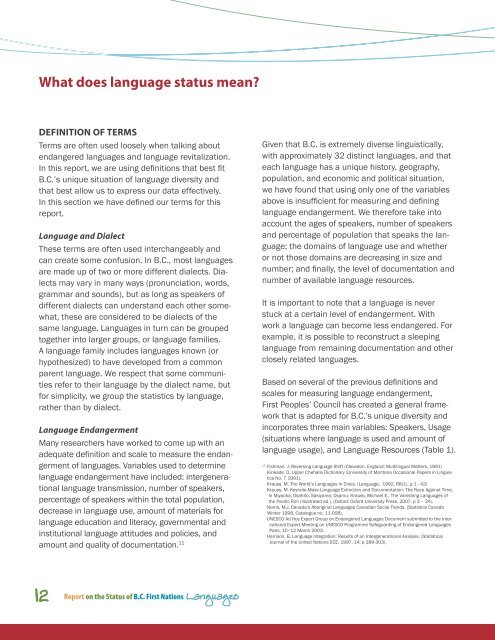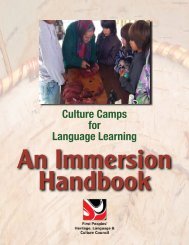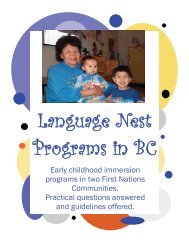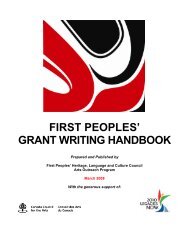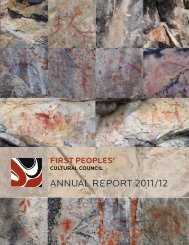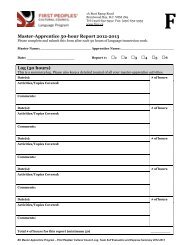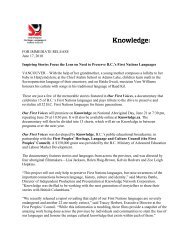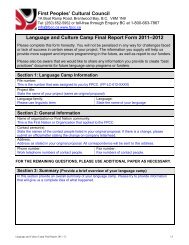What is the status of BC First nations languages? - First Peoples
What is the status of BC First nations languages? - First Peoples
What is the status of BC First nations languages? - First Peoples
Create successful ePaper yourself
Turn your PDF publications into a flip-book with our unique Google optimized e-Paper software.
<strong>What</strong> does language <strong>status</strong> mean?Definition <strong>of</strong> TermsTerms are <strong>of</strong>ten used loosely when talking aboutendangered <strong>languages</strong> and language revitalization.In th<strong>is</strong> report, we are using definitions that best fitB.C.’s unique situation <strong>of</strong> language diversity andthat best allow us to express our data effectively.In th<strong>is</strong> section we have defined our terms for th<strong>is</strong>report.Language and DialectThese terms are <strong>of</strong>ten used interchangeably andcan create some confusion. In B.C., most <strong>languages</strong>are made up <strong>of</strong> two or more different dialects. Dialectsmay vary in many ways (pronunciation, words,grammar and sounds), but as long as speakers <strong>of</strong>different dialects can understand each o<strong>the</strong>r somewhat,<strong>the</strong>se are considered to be dialects <strong>of</strong> <strong>the</strong>same language. Languages in turn can be groupedtoge<strong>the</strong>r into larger groups, or language families.A language family includes <strong>languages</strong> known (orhypo<strong>the</strong>sized) to have developed from a commonparent language. We respect that some communitiesrefer to <strong>the</strong>ir language by <strong>the</strong> dialect name, butfor simplicity, we group <strong>the</strong> stat<strong>is</strong>tics by language,ra<strong>the</strong>r than by dialect.Language EndangermentMany researchers have worked to come up with anadequate definition and scale to measure <strong>the</strong> endangerment<strong>of</strong> <strong>languages</strong>. Variables used to determinelanguage endangerment have included: intergenerationallanguage transm<strong>is</strong>sion, number <strong>of</strong> speakers,percentage <strong>of</strong> speakers within <strong>the</strong> total population,decrease in language use, amount <strong>of</strong> materials forlanguage education and literacy, governmental andinstitutional language attitudes and policies, andamount and quality <strong>of</strong> documentation. 11Given that B.C. <strong>is</strong> extremely diverse lingu<strong>is</strong>tically,with approximately 32 d<strong>is</strong>tinct <strong>languages</strong>, and thateach language has a unique h<strong>is</strong>tory, geography,population, and economic and political situation,we have found that using only one <strong>of</strong> <strong>the</strong> variablesabove <strong>is</strong> insufficient for measuring and defininglanguage endangerment. We <strong>the</strong>refore take intoaccount <strong>the</strong> ages <strong>of</strong> speakers, number <strong>of</strong> speakersand percentage <strong>of</strong> population that speaks <strong>the</strong> language;<strong>the</strong> domains <strong>of</strong> language use and whe<strong>the</strong>ror not those domains are decreasing in size andnumber; and finally, <strong>the</strong> level <strong>of</strong> documentation andnumber <strong>of</strong> available language resources.It <strong>is</strong> important to note that a language <strong>is</strong> neverstuck at a certain level <strong>of</strong> endangerment. Withwork a language can become less endangered. Forexample, it <strong>is</strong> possible to reconstruct a sleepinglanguage from remaining documentation and o<strong>the</strong>rclosely related <strong>languages</strong>.Based on several <strong>of</strong> <strong>the</strong> previous definitions andscales for measuring language endangerment,<strong>First</strong> <strong>Peoples</strong>’ Council has created a general frameworkthat <strong>is</strong> adapted for B.C.’s unique diversity andincorporates three main variables: Speakers, Usage(situations where language <strong>is</strong> used and amount <strong>of</strong>language usage), and Language Resources (Table 1).11F<strong>is</strong>hman. J. Reversing Language Shift (Clevedon, England: Multilingual Matters, 1991)Kinkade, D. Upper Chehal<strong>is</strong> Dictionary (University <strong>of</strong> Montana Occasional Papers in Lingu<strong>is</strong>ticsNo. 7 1991).Krauss, M. The World’s Languages in Cr<strong>is</strong><strong>is</strong>. (Language, 1992, 68(1). p 1 - 42)Krauss, M. Keynote-Mass Language Extinction and Documentation: The Race Against Time,In Miyaoka, Osahito; Sakiyama, Osamu; Krauss, Michael E., The Van<strong>is</strong>hing Languages <strong>of</strong><strong>the</strong> Pacific Rim (illustrated ed.), (Oxford: Oxford University Press, 2007, p 3 – 24).Norr<strong>is</strong>, M.J. Canada’s Aboriginal Languages Canadian Social Trends. (Stat<strong>is</strong>tics CanadaWinter 1998, Catalogue no. 11-008).UNESCO Ad Hoc Expert Group on Endangered Languages Document submitted to <strong>the</strong> InternationalExpert Meeting on UNESCO Programme Safeguarding <strong>of</strong> Endangered LanguagesPar<strong>is</strong>, 10–12 March 2003.Harr<strong>is</strong>on, B. Language Integration: Results <strong>of</strong> an Intergenerational Analys<strong>is</strong>. (Stat<strong>is</strong>ticalJournal <strong>of</strong> <strong>the</strong> United Nations ECE, 1997, 14: p 289-303).12Report on <strong>the</strong> Status <strong>of</strong> B.C. <strong>First</strong> Nations Languages


